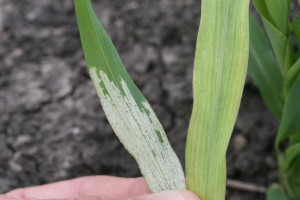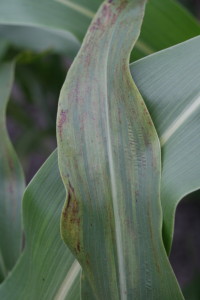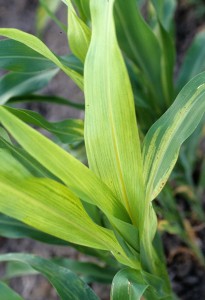by Thomas Isakeit, Professor and Extension Plant Pathologist, t-isakeit@tamu.edu
Sorghum downy mildew is a disease that has potential to cause yield loss to susceptible hybrids if there is a high incidence in the field. Previous research has shown yield losses if disease incidence exceeds 30%. The disease occurs most commonly in the Upper Coast counties, and has usually been associated with fields grown under monoculture with hybrids susceptible to pathotypes 3 or 6. The seedling stage, about 3 to 4 weeks after planting, is a good growth stage to determine the incidence of disease in the field, since the initial infections occurring in soil that lead to systemically-infected plants occur before then, and do not occur thereafter.
Leaves of systemically-infected seedlings have a mottled, pale green appearance, often with a fuzzy white sporulation of the fungus on the underside of the leaf (Fig. 1). With frequent rains this spring, another symptom of downy mildew is the local lesion (Fig. 2). Local lesions arise from spores (“sporangia”) that are blown from systemically-infected plants in the same field, or neighboring fields. While these leaf symptoms look horrible, they will not affect yield, nor do they pose a long-term threat to productivity. The fungus does not survive to the next season in these leaves. As the season progresses, and temperatures increase, the conditions become unfavorable for new local lesion production and they will not be present or prevalent on upper leaves of the plant.
However, with some hybrids that are very susceptible to downy mildew, spore infections of leaves can sometimes lead to systemic infections (Fig. 3). These are local lesion systemics and with such infected plants, there is an absence of downy mildew infections on lower leaves. These local lesion systemics can be problematic, as they are capable of producing spores (“oospores”) that can carry over to the next year. Additionally, this is a means that the pathogen can be introduced into new fields. Growers need to be aware of this to manage a potential future disease problem.
For more information on diagnosis (http://amarillo.tamu.edu/files/2010/11/sorghum_downymildew.pdf) and management (http://amarillo.tamu.edu/files/2010/11/SorghumDownyMildewPart2.pdf) of sorghum downy mildew, see these fact sheets.

Thomas Isakeit, Ph.D.
Professor and Extension Plant Pathologist
College Station, TX
t-isakeit@tamu.edu


